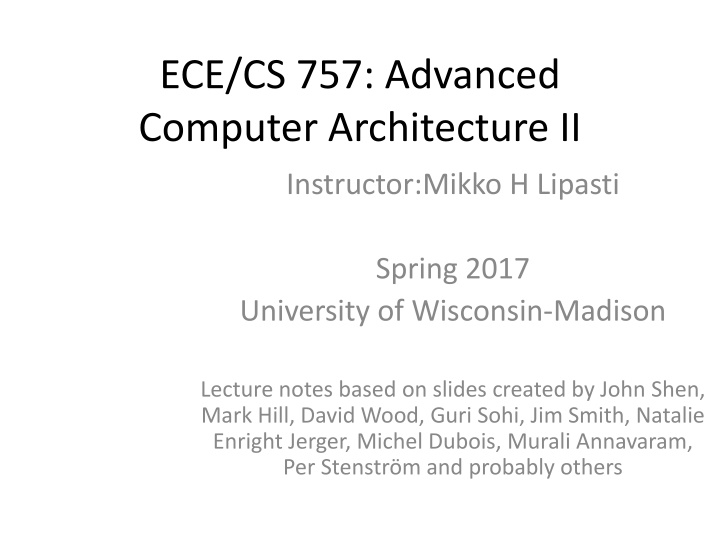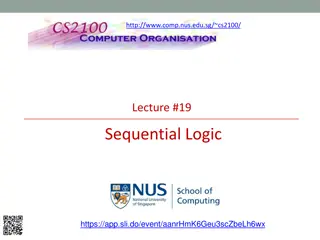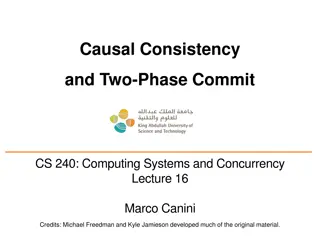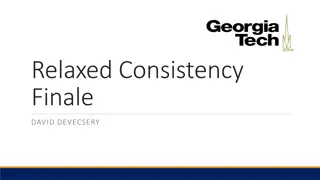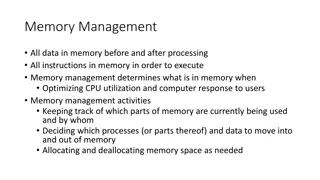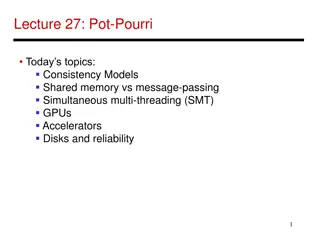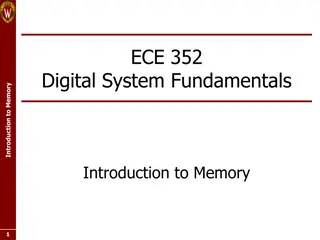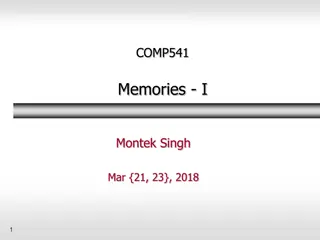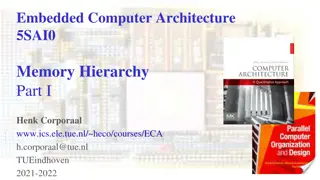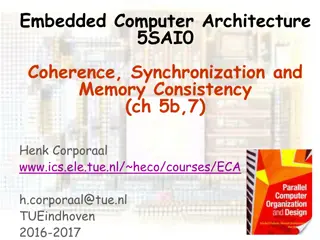Memory Consistency Models and Sequential Consistency in Computer Architecture
Memory consistency models play a crucial role in ensuring proper synchronization and ordering of memory references in computer systems. Sequential consistency, introduced by Lamport in 1979, treats processors as interleaved processes on a shared CPU and requires all references to fit into a global order. Maintaining high-performance sequential consistency involves coherent caches isolating CPUs, allowing speculative reference reordering, and tracking speculative address touches for efficient execution.
Download Presentation

Please find below an Image/Link to download the presentation.
The content on the website is provided AS IS for your information and personal use only. It may not be sold, licensed, or shared on other websites without obtaining consent from the author.If you encounter any issues during the download, it is possible that the publisher has removed the file from their server.
You are allowed to download the files provided on this website for personal or commercial use, subject to the condition that they are used lawfully. All files are the property of their respective owners.
The content on the website is provided AS IS for your information and personal use only. It may not be sold, licensed, or shared on other websites without obtaining consent from the author.
E N D
Presentation Transcript
ECE/CS 757: Advanced Computer Architecture II Instructor:Mikko H Lipasti Spring 2017 University of Wisconsin-Madison Lecture notes based on slides created by John Shen, Mark Hill, David Wood, Guri Sohi, Jim Smith, Natalie Enright Jerger, Michel Dubois, Murali Annavaram, Per Stenstr m and probably others
Lecture 6 Outline UNDERSTANDING CONSISTENCY MODELS Atomicity Program Ordering Visibility POPULAR CONSISTENCY MODELS Sequential Consistency IBM/370 Processor Consistency SPARC TSO/PSO/RMO Weak Ordering PowerPC Weak Consistency VISIBILITY MEMORY REFERENCE REORDERING Mikko Lipasti-University of Wisconsin 2
Basics of Memory Consistency (Ordering) How are memory references from different processors interleaved? If this is not well-specified, synchronization becomes difficult or even impossible ISA must specify consistency model Common example using Dekker s algorithm for synchronization If load reordered ahead of store (as we assume for a baseline OOO CPU) Both Proc0 and Proc1 enter critical section, since both observe that other s lock variable (A/B) is not set If consistency model allows loads to execute ahead of stores, Dekker s algorithm no longer works Common ISAs allow this: IA-32, PowerPC, SPARC, Alpha Mikko Lipasti-University of Wisconsin 3
Sequential Consistency [Lamport 1979] Processors treated as if they are interleaved processes on a single time-shared CPU All references must fit into a total global order or interleaving that does not violate any CPU s program order Otherwise sequential consistency not maintained Now Dekker s algorithm will work Appears to preclude any OOO memory references Hence precludes any real benefit from OOO CPUs Mikko Lipasti-University of Wisconsin 4
High-Performance Sequential Consistency Coherent caches isolate CPUs if no sharing is occurring Absence of coherence activity means CPU is free to reorder references Still have to order references with respect to misses and other coherence activity (snoops) Key: use speculation Reorder references speculatively Track which addresses were touched speculatively Force replay (in order execution) of such references that collide with coherence activity (snoops) Mikko Lipasti-University of Wisconsin 5
High-Performance Sequential Consistency Load queue records all speculative loads Bus writes/upgrades are checked against LQ Any matching load gets marked for replay At commit, loads are checked and replayed if necessary Results in machine flush, since load-dependent ops must also replay Practically, conflicts are rare, so expensive flush is OK Mikko Lipasti-University of Wisconsin 6
Relaxed Consistency Models Key insight: only synchronization references need to be ordered Hence, relax memory for all other references Enable high-performance OOO implementation Require programmer to label synchronization references Hardware must carefully order these labeled references All other references can be performed out of order Labeling schemes: Explicit synchronization ops (acquire/release) Memory fence or memory barrier ops: All preceding ops must finish before following ones begin Often: fence ops cause pipeline drain in modern OOO machine Mikko Lipasti-University of Wisconsin 7
Why Relaxed Consistency Models? Original motivation Allow in-order processors to overlap store latency with other work Other work depends on loads, hence must let loads bypass stores and execute early: implement a store queue This breaks sequential consistency assumption that all references are performed in program order This led to definition of processor consistency, SPARC TSO, IBM/370 All of these relax read-to-write program order requirement Subsequent developments It would be nice to overlap latency of one store with latency of other stores Allow stores to be performed out of order with respect to each other This breaks SC even further This led to definition of SPARC PSO/RMO, WO, PowerPC WC, Itanium What s the problem with relaxed consistency? Shared memory programs can break if not written for specific cons. model Mikko Lipasti-University of Wisconsin 8
Understanding Consistency Models Proc0 Proc1 st A ld B ld A st B Consistency model defines how memory references are ordered across processors/threads Part of the instruction set architecture PowerPC, SPARC, IA-32, etc. each have their own consistency model In some cases, more than one! The program semantics will change with consistency model More relaxed consistency models enable more correct outcomes Even strict consistency models allow multiple correct outcomes Mikko Lipasti-University of Wisconsin 9
Understanding Consistency Models Proc0 st A ld B Proc1 st B ld A RAW dependences to/from Proc0/Proc1 may or may not occur Also, WAR and WAW dependences may or may not occur Relatively simple set of rules governs which {RAW,WAR,WAW} edges are required (must be observed), which ones are not required Observing certain edges provides visibility to other processors Hence requires us to observe (some) subsequent edges Causality: If I observe A, and B is ordered before A, I must also observe B Without causality, system becomes virtually impossible to program Mikko Lipasti-University of Wisconsin 10
Constraint graph Defined for sequential consistency by Landin et al., ISCA-18 Directed graph represents a multithreaded execution Nodes represent dynamic instruction instances Edges represent their transitive orders (program order, RAW, WAW, WAR). If the constraint graph is acyclic, then the execution is correct Cycle implies A must occur before B and B must occur before A => contradiction Mikko Lipasti-University of Wisconsin 11
Constraint graph example - SC Proc 1 Proc 2 WAR 2. ST A 4. LD B Program order Program order ST B LD A 3. RAW 1. Cycle indicates that execution is incorrect Mikko Lipasti-University of Wisconsin 12
Anatomy of a cycle Proc 1 Proc 2 Incoming invalidate ST A WAR LD B Program order Cache miss Program order ST B RAW LD A Mikko Lipasti-University of Wisconsin 13
High-Performance Sequential Consistency Load queue records all speculative loads Bus writes/upgrades are checked against LQ Any matching load gets marked for replay At commit, loads are checked and replayed if necessary Results in machine flush, since load-dependent ops must also replay Practically, conflicts are rare, so expensive flush is OK Mikko Lipasti-University of Wisconsin 14
Understanding Relaxed Consistency Three important concepts Atomicity do writes appear at the same time to all other processors? Program order do my references have to be ordered with respect to each other? Visibility (causality) Does anyone care? This is the most subtle... Mikko Lipasti-University of Wisconsin 15
Possible Relaxations Relax Write to Read program order Relax Write to Write program order Relaxation Relax Read to Read and Write to Write program order Read others write early Read own write early From widely cited tech report: [Adve/Gharachorloo, Shared Memory Consistency Models: A Tutorial ] Mikko Lipasti-University of Wisconsin 16
Sequential Consistency Informally, all processors references are interleaved in total global order Multiple total global orders are possible and correct Order determined in somewhat arbitrary manner On bus-based SMP, by order in which bus is acquired On directory-based system like Origin 2000, order in which requests are acked (not order in which they arrive) All processors must maintain total order among their own references Again, key is to maintain illusion of order (visibility) Mikko Lipasti-University of Wisconsin 17
SC and ILP SC appears to preclude high performance, ILP (loads after stores) Can use speculation and prefetching to avoid these bottlenecks Prefetch load data, store ownership early as soon as address known and load/store issues in OOO core Hold off committing result until load/store has been ordered at commit If conflicting remote event occurs before then, squash speculation conflicting event == invalidate message for matching address If load, refetch instruction stream If store, fetch line ownership again Mikko Lipasti-University of Wisconsin 18
SC and ILP How to support speculation and rollback? Simple speculation within OOO window: MIPS R10000 Aggressive speculation: Speculative retirement [Ranganathan et al., SPAA 1997] Speculative stores [Gniady et al., ISCA 1999] Kilo-instruction checkpointing: Safetynet [Sorin Ph.D. thesis, U. Wisconsin] Latencies growing to 100s of cycles, need potentially huge speculation buffers Mikko Lipasti-University of Wisconsin 19
Recent Trends Many are arguing that SC is best approach ILP/speculation can be used to match performance of relaxed models Adve, Falsafi, Hill all seem to be arguing this Is it really true? Conventional wisdom was that SC ordering rules must be relaxed to achieve performance Latencies relative to processor core are quite long in large- scale (multisocket) systems Can massive, power-hungry speculation buffers really be justified/implemented? Reality: All modern ISAs (ARM, Alpha, PowerPC, IA-64) have weak consistency models Existence proof that programmers are willing to tackle the complexity Even less modern ISAs (IA-32, IBM/370) have relaxed models Mikko Lipasti-University of Wisconsin 20
Recent Trends Recent trend toward simple processor cores Sun/Oracle Niagara (SPARC TSO) Intel Atom (Intel model, TSO-like) GPU shader cores These will not easily tolerate consistency-related stalls Multithreading helps GPU/GPGPU vendors are sidestepping the issue Not really supporting shared memory However, atomic operations are supported These require a consistency model Usually assumed to be SC like As long as atomic operations are rare, this is OK Mikko Lipasti-University of Wisconsin 21
Sequential Consistency No reordering allowed Writes must be atomic Except can read own write early Mikko Lipasti-University of Wisconsin 22
IBM/370 Consistency Similar to IA-32 Read->Write order relaxed Writes must occur atomically (others cannot read write early) Cannot read own write early! (not true for IA-32) Mikko Lipasti-University of Wisconsin 23
Processor Consistency Same as IBM/370, except writes not atomic Relax read to write order Writes need not occur atomically Mikko Lipasti-University of Wisconsin 24
SPARC TSO One of 3 SPARC consistency models determined by MSW mode bits This is the one actually used by real programs Reads may bypass writes Writes must be atomic Mikko Lipasti-University of Wisconsin 25
What Breaks? When relaxing read->write program order, what breaks? Dekker s algorithm for mutual exclusion: initially A=B=0 Since read of B bypasses store of A on Proc0 (and vice versa on Proc1), mutual exclusion is no longer guaranteed: Neither processor sees other s write since reads are moved up Both processors believe they have mutually exclusive access Fix? Programmer must insert memory barriers between store and load Force store to complete before load is performed If stores not atomic (in PC), memory barrier must force atomicity Mikko Lipasti-University of Wisconsin 26
SPARC PSO SPARC second attempt at consistency model (not used) Reads may pass writes; writes may pass writes Writes must be atomic (cannot read other s write early) Mikko Lipasti-University of Wisconsin 27
What Breaks? Store flag bypasses store of A Proc0 st A=1 st flag=0 Proc1 while (flag==1) {}; print A When writes can pass writes in program order, what breaks? Producer-consumer pattern (e.g. OS control block update) Update control block, then set flag to tell others you are done with your update Proc1 sees store of flag before it sees store of A, and reads stale copy of A Fix? Programmer must insert store memory barrier between two stores on Proc0 Hardware forces st A to complete before st flag is performed Mikko Lipasti-University of Wisconsin 28
SPARC RMO SPARC third attempt at a relaxed consistency model Fully relaxed ordering Writes must still be atomic Mikko Lipasti-University of Wisconsin 29
Weak Ordering Equivalent to SPARC RMO Used by Alpha Fully relaxed ordering; writes must be atomic Mikko Lipasti-University of Wisconsin 30
What Breaks? Proc0 st A=1 membar st flag=0 Proc1 Read of A bypasses read of flag if (flag==0) print A When reads can pass reads, what breaks? Similar example as when writes can pass writes Proc1 moves up read of A and reads stale value Usually this requires branch prediction Branch misprediction recovery won t help! Branch was predicted correctly; flag was set to 0 by the time Proc1 reads flag Fix? Programmer must insert membar between two loads on Proc1 as well Mikko Lipasti-University of Wisconsin 31
What Else Breaks? Proc0 st *A=1 membar st head=A Proc1 Data dependence prevents ld R2 from bypassing ld R1 ld R1=head ld R2=*R1 When reads can pass reads, what else can break? Data dependence ordering is assumed even in weaker models Typical use: create new linked list entry, initialize it, insert it on head of list Force update of head of list to occur last (membar) Expect that Proc1 won t be able to dereference head until after its been updated due to data dependence between ld R1 and ld R2 Wrong! What happens with value prediction? Proc1 predicts value of R1, performs ld R2 with predicted R1, gets stale data Then, it validates R1 predicted value by performing load of head and values match: no value misprediction! Yet Proc1 read stale value of A Or, network reorders updates of head and *head Mikko Lipasti-University of Wisconsin 32
What Else Breaks? Proc0 st *A=1 membar st head=A Proc1 Data dependence prevents ld R2 from bypassing ld R1 ld R1=head ld R2=*R1 Fix? Programmer must insert membar between two loads on Proc1 Cannot rely on data dependence ordering of loads PowerPC OK (fixed in ISA document, previously undefined) Alpha requires membar (will break without it) -- expensive! Example of incomplete ISA definition due to assumptions about implementation Assume no value prediction! Ref: [Martin et al., MICRO 2001] Mikko Lipasti-University of Wisconsin 33
PowerPC Weak Ordering Fully relaxed ordering Writes need not be atomic Mikko Lipasti-University of Wisconsin 34
What Breaks? Proc0 st A=1 Proc1 while (A==0); st B=1 Proc2 while (B==0); print A (st A arrives late at Proc2) When stores are no longer atomic, what breaks? 3-processor example required to demonstrate transitivity: Proc1 writes B after it sees Proc0 s write of A Proc2 reads A after it sees Proc1 s write of B Proc2 gets stale copy of A since write from Proc0 hasn t arrived yet Fix? Proc2 s read of A must be an atomic RMW operation (or ll/sc), which will force it to be ordered after Proc0 s write of A Note that a membar at Proc1 or a membar at Proc0 do not help Mikko Lipasti-University of Wisconsin 35
How Do We Synchronize? With SC, synchronization can be accomplished with e.g. Dekker s algorithm, which relies on store->load ordering With weaker models, synchronization operations need to be explicitly identified to the processor. Processor then treats synchronization operations with stricter rules E.g. release consistency (RC) uses explicit acquire and release primitives which are strongly ordered, while standard loads and stores are weakly ordered Acquire and release protect mutually exclusive regions (critical sections) These impose ordering fences or barriers on other memory operations, which are otherwise unordered. Acquire: full memory barrier, all previous loads and stores ordered with respect to all subsequent loads and stores, all remote stores must be visible to subsequent loads Release: write memory barrier, all previous stores ordered with respect to all subsequent stores (i.e. all critical section updates visible to everyone before release visible). Mikko Lipasti-University of Wisconsin 36
Release Consistency Proc0 acquire (lock) st A release (lock) Proc1 acquire(lock) load A store B release (lock) Acquire/Release pairs protect critical sections Without special semantics for acquire/release load A may not see st A due to relaxed ordering Instead: Proc0 release forces all prior writes to be visible to all other processors before lock release is visible to anyone Furthermore, Proc1 acquire prevents subsequent reads or writes from being performed before acquire has completed In proposed RC systems, acquire and release are special instructions; Hardware knows to treat them with stricter ordering rules Special acquire/release instructions are not strictly necessary Mikko Lipasti-University of Wisconsin 37
Synchronization in Weak Models RC not actually implemented in any cache-coherent hardware Lots of proposals for RC variants in software-based DSM (SVM) RC can be approximated in weakly consistent systems by providing two flavors of memory barrier instructions Acquire: corresponds to full memory barrier (Alpha membar, PowerPC sync) Release: corresponds to store memory barrier (Alpha stmembar, PPC lwsync) Memory barriers after lock acquire and before lock release achieve benefits of release consistency Mikko Lipasti-University of Wisconsin 38
Synchronization in Weak Models Proc0 ll/sc pin lock membar st A stmembar st lock Proc1 Later un- related load can still move up ll/sc spin lock membar load A st B stmembar st lock ld X Acquire/release are programmer-annotated with appropriate membar Mikko Lipasti-University of Wisconsin 39
Synchronization Burden is on programmer to protect all shared accesses with locks, critical sections, and use acquire/release primitives If no acquire/release or membar instructions, then what? Usually fall back on atomic RMW instructions (compare-and-swap) These either have special ordering semantics, or force ordering because they do both a read and a write simultaneously In 370/TSO/IA-32, many sync. primitives (e.g. ll/sc spin loops) work without barriers (barriers are implicit) Bottom line: can t write correct shared-memory programs in WC systems without synchronization! WC rules allow arbitrary delays, meaning other processors may never see your writes Synchronization ops and memory barriers force writes to be visible to other processors Mikko Lipasti-University of Wisconsin 40
What About Visibility/Causality? None of these definitions clarify what is meant by visibility (i.e. ISA spec says something like it must appear as if R->W order is maintained... ) What does this mean? The programmer must not be able to detect that references have been reordered Or, bounds must be set on how much slack each reference has Also known as causality Construct a constraint graph: Identify all {PO,RAW,WAR,WAW} edges that have occurred between processors (i.e. all dependences that have been observed in the past) These are what indicate visibility or causality to another processor s references Then determine which (if any) prior {RAW,WAR,WAW} edge implies causality (else cycle will form) The rules for which types of PO (program order) edges are present depend on the consistency model s relaxation of rd- >rd, wr->wr, rd->wr, etc. Mikko Lipasti-University of Wisconsin 41
4 Simple Steps to Understanding Causality 1. Single mem ref/CPU Load can use any version (bind to ) Stores? Coherence requires total order per address: A0, A1, A2 P0 P1 P2 P3 ld A0-2 ld A0-2 st A1 st A2 Mikko Lipasti-University of Wisconsin 42
4 Simple Steps to Understanding Causality 2. Two or more mem refs to same address/CPU: Causality through coherence kicks in: two refs must interleave into global order correctly i. ld A ld A ii. ld A st A iii. st A ld A iv. st A st A Case OK !OK Note i ld A1 ld A3 ld A0 st A1-3 st A2 ld A2-3 st A1 st A2-3 ld A2 ld A1 ld A2 st A1 st A2 ld A1 st A2 st A1 A2 implies A2-3 ii A2 implies A3 iii Also 1T RAW Store Order iv A0 A1 A2 A3 Also 1T WAW Mikko Lipasti-University of Wisconsin 43
4 Simple Steps to Understanding Causality 3. Two or more mem refs to diff address/CPU: Causality through consistency kicks in: two addresses are now synchronized i. ld A ld B ii. ld A st B iii. st A ld B iv. st A st B Case OK !OK Note i ld A1 ld B0-3 ld A0 st B0-3 st A2 ld B1-3 st A0 st B0-3 ld A2 ld B0 ld A3 st B1 st A2 ld B0 st A3 st B0 A2 implies B1-3 ii A2 implies B2-3 iii A2 implies B1-3 Store Order iv A0 A1 A2 A3 B0 B1 B2 B3 A3 implies B2-3 E.g. program order st B1->st A2 Mikko Lipasti-University of Wisconsin 44
4 Simple Steps to Understanding Causality 4. Causality extends transitively across all memory locations and all processors in the system P0 P1 P2 Notes (assumes SC) st A1 st B1 ld B1 st C1 Causal RAW st A2 ld C1 ld A? ld B? Causal RAW st B2 Implies A1 (A2 OK also) Implies B1 (B2 OK also) Mikko Lipasti-University of Wisconsin 45
Causality Example Proc0 st A st B Proc1 RA W ld B ld A Can ld A move up? Assuming SC stB -> ld B RAW edge was observed (i.e. Proc1/ld B got its value from Proc0) SC ordering rules imply that all prior stores from Proc0 must now be visible to Proc1; Proc0/st A is upper bound on slack for ld A Hence, Proc1/ld A must get its value from Proc0/st A How does the hardware track this? In MIPS R10000, ld A can be reordered (issued) ahead of ld B However, ld A is retired after ld B. Since st A/st B are performed in order at Proc0, the fact that Proc1 observed st B before retiring ld B implies it observed st A before it retires ld A. Hence, violation is detected and ld A reissues For this to work, writes to A and B must be ordered! Mikko Lipasti-University of Wisconsin 46
Causality Example 2 Proc0 st A ld B Proc1 W AR st B ld A More subtle case (Dekker s algorithm), again assuming SC ld B -> st B WAR edge was observed (i.e. Proc0/ld B did not get its value from Proc1/st B) SC ordering rules imply that all prior stores from Proc0 must now be visible to Proc1; Proc0/st A is upper bound on slack for Proc1/ld A Hence, Proc1/ld A must get its value from Proc0/st A How does the hardware track this? In MIPS R10000, ld A can be reordered (issued) ahead of st B However, ld A is retired after st B. Since st A/ld B are retired in order at Proc0, we know that Proc1/st B had to occur after ld B (o/wise ld B would get refetched). Hence st A will have reached Proc1 before ld A can retire Hence, violation is detected and ld A reissues For this to work, the write to A must complete before ld B retires! Mikko Lipasti-University of Wisconsin 47
Causality Example 3 Proc0 st A st B Proc1 W AW st B ld A More subtle case, again assuming SC st B -> st B WAW edge was observed (i.e. Proc1/st B was ordered after Proc0/st B) SC ordering rules imply that all prior stores from Proc0 must now be visible to Proc1; Proc0/st A is upper bound on slack for ld A Hence, Proc1/ld A must get its value from Proc0/st A How does the hardware track this? In MIPS R10000, ld A can be reordered (issued) ahead of st B However, Proc0/st A is retired before Proc0/st B. Since Proc1/st B occurs after Proc0/st B, and ld A retires after Proc1/st B, we know that Proc0/st A had to reach Proc1 before ld A can retire Hence, violation is detected and ld A reissues For this to work, the writes of A and B must be ordered! Mikko Lipasti-University of Wisconsin 48
What About Weaker Models? Proc0 st A membar st B Proc1 W AW st B membar ld A Causality rules are in fact very similar, only the granularity changes In WC, upper bound on slack for a load is not the store preceding an observed RAW/WAR/WAW edge, but the store (if any) preceding the membar before the observed RAW/WAR/WAW edge preceding your latest membar. If either membar absent, Proc0/st A is not the upper bound on slack for ld A Would have to search backward in Proc0 to find st A prior to latest membar preceding st B Any edges in same epoch (after latest membar) don t matter until next epoch Mikko Lipasti-University of Wisconsin 49
What About Weaker Models? Proc0 st A membar st B Proc1 W AW st B membar ld A In 370/TSO (relaxed read-to-write), upper bound on slack for a load depends only on observed RAW edges, since WAR/WAW edges terminate in stores, and loads are allowed to bypass stores Hence any tracking mechanism would only consider observed RAW edges Need Proc1 membar above to force ld A to see effects of st A Mikko Lipasti-University of Wisconsin 50
